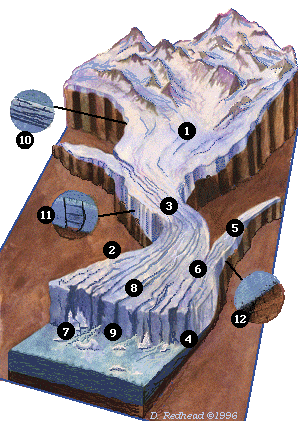Anatomy of a Glacier

Anatomy of a Glacier Definitions
Key terms are highlighted
- The accumulation (input) zone is where a glacier gains snow and ice through snowfall and compression. Ice begins to flow like a conveyor belt, driven by gravity and ever mounting snows.
- In the lower region or ablation (output) zone, the glacier loses ice through melting and evaporation. Older ice is carried down to greater and greater depth.
- An equilibrium line divides the two areas. This spot is like an old fashioned pair of scales used to weigh gold dust.
- Advancing ice scrapes and grinds the bedrock, boulders, and gravel beneath it and pushes a ridge of terminal moraine in front.
- Another, or tributary, glacier sometimes joins the main flow, adding another strip of lateral moraine debris. The two lateral moraines combine to form a single medial moraine, which now extends down the middle of the glacier towards the snout.
- When two lateral moraines combine, they form a single medial moraine, which extends down the middle of the glacier towards the snout. When medial moraines come close to one another near the terminus, a glacier may look multicolored or striped.
- Glacier ice melts and fractures, and the sea often batters it. Finally, chunks of ice break off as icebergs in a process called calving, which balances the flow of ice from behind.
- Near the terminus (end) of a glacier, its surface thins and stretches and breaks into a mosaic of crevasses.
- Meltwater flows through hidden channels and tunnels.
- Snow to Ice: Water seeps through accumulated snow and gradually forms horizontal “ice lenses” and vertical “glands.” Eventually, the whole mass compresses into a deep bed of dense ice.
- Ice Flow: Bending of a vertical bore hole (left) shows how a glacier moves by internal deformation and sliding at the base (red arrow).
- Glacier Bed: Glaciers move by sliding over bedrock or underlying gravel and rock debris. With the increased pressure because of the weight, the individual ice grains slide past one another and the ice moves slowly downhill. Water lubrication is crucial to either process. The sliding of the glacier over its bed is called basal slip.
Anatomy of a Surge
Surge
When a glacier surge occurs, rapid downstream motion and stretching of the ice can advance the terminus by many kilometers. The glacier may swallow its own valley. A surge is a short period when a glacier can go as much as 100 times faster than it normally goes. Traveling waves during the surge and the advancing surge front can actually move much more rapidly than the rest of the glacier. The rest of the glacier is also traveling faster than usual.
Surge Definitions
A. When not surging, the glacier contains cracks and tunnels that drain off meltwater. See: Moulin
B. If the meltwater system gets blocked, water pressure can lift and lubricate part of the ice stream, letting the glacier slide rapidly downhill. See: Surge
C. While the surge happens, the glacier heaves and undulates like a moving caterpillar. See: Galloping Glacier
D. Surges can end suddenly as the blocked water gushes out at the face. These downward gallops occur in only a small percentage of Alaska’s glaciers. See: Jokulhlaup

Types of Crevasses

Also see crevasses.
Anatomy
Vocabulary Plus
accumulation zone
ablation zone
equilibrium line
moraine
tributary
terminal moraine
calving
terminus
meltwater
moulin
surge
jokulhlaup
Review Questions
Look at the first diagram
- Is the accumulation zone near the upper or lower region of a glacier?
- Is the ablation zone near the upper or lower region of a glacier?
- The process of calving stops, balances, or increases (pick one) the flow of ice from behind.
- True or False: Meltwater flows along the top of glaciers.
- Explain what process is occurring in #3 on the glacier anatomy image. What does it tell you?
Look at “Anatomy of a Surge,” which shows the stages of a surging glacier
- What is the fastest a glacier can surge: 5 times faster than it normally goes or 100 times faster than it normally goes?
- In a surge, can a glacier swallow its own valley?
- In the diagram in this section that shows what happens when a glacier surges, look at letter B and find out what it’s about.
The next figure is a diagram of kinds of crevasses created by stresses within glaciers. Look closely.
9. Draw a diagram of shearing at the side of a glacier. (Hint: it’s in the diagram of “types of crevasses”)
Brain Challenge!
Do you think a surging glacier could knock down Denali?
Exercise: Matching
___accumulation zone
___ablation zone
___tributary
___moraine
___terminus
A. A glacier that joins the main flow.
B. Where a glacier gains snow and ice through snowfall and compression
C. Helps anchor the glacier’s ice.
D. In the lower region of a glacier; this loses ice through melting and evaporation
E. The end of a glacier; the surface thins and stretches
Project: Drawing Glacier Anatomy
See if you can draw these parts of a glacier from memory. If you need help, look in the glossary for definitions.
- Terminus
- Tributary
- Accumulation Zone
Check yourself! Go back to the anatomy section of Glacier Power and look. Were you right?